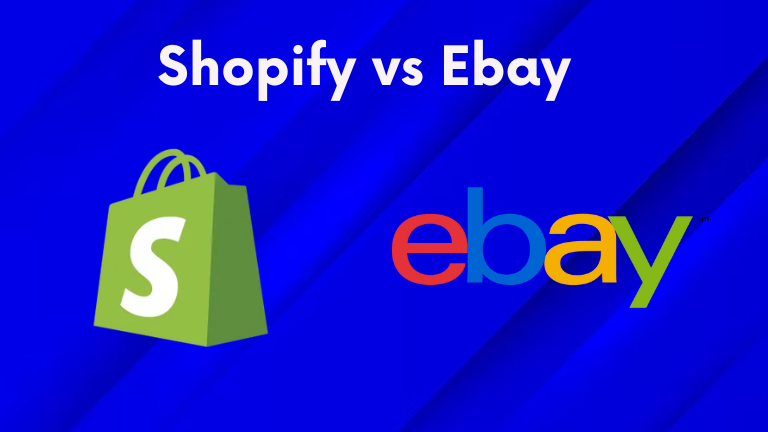
Shopify and eBay, Both platforms offer unique advantages and cater to diverse business needs, but the question remains – which one is the right fit for your online venture? This comprehensive guide delves deep into the intricacies of these ecommerce powerhouses, providing an unbiased analysis to help you make an informed decision. Whether you’re a budding entrepreneur or an established brand seeking growth, this article will equip you with the knowledge to navigate the intricate landscape of online selling.
Shopify vs eBay: A Clash of Ecommerce Giants
Shopify vs eBay, two names that have etched their mark in the ecommerce realm, represent contrasting approaches to online selling. While Shopify empowers businesses to build their own branded online stores, eBay operates as a vast global marketplace, connecting buyers and sellers from around the world.
At its core, Shopify is a purpose-built ecommerce platform that offers a blank canvas for businesses to create their dream online store. From designing a visually stunning website to managing inventory and shipping, Shopify provides a comprehensive suite of tools tailored for ecommerce success. On the other hand, eBay is a well-established online marketplace where sellers can list their products and tap into a vast pool of potential buyers.
Choosing between shopify vs ebay requires a deep understanding of your business goals, target audience, and long-term growth aspirations. This guide will navigate you through the intricate details of Shopify vs eBay, shedding light on their strengths, weaknesses, and unique offerings.
Shopify vs eBay: Ease of Use and Onboarding
When embarking on an ecommerce journey, a smooth and seamless onboarding process can make all the difference. Both Shopify and eBay have streamlined their setup procedures, but they differ in their approach and complexity.
eBay: Ease of Use and Onboarding
eBay’s onboarding process is a testament to its user-friendly nature. Whether you opt for a Personal or Business account, the platform guides you through a series of straightforward questions, culminating in your dashboard’s unveiling. From there, listing your first product is a breeze, with eBay’s step-by-step prompts ensuring a seamless experience. Within minutes, your online store can be up and running, ready to welcome its first customers.
Shopify: Ease of Use and Onboarding
Shopify’s setup process is slightly more involved, reflecting its commitment to providing a fully customizable ecommerce experience. After answering a few questions about your business during registration, you’ll be greeted by the Shopify dashboard. Here, a handy task sheet will guide you through the setup process, from designing your online store’s aesthetic to uploading your products.
While Shopify’s approach may require a bit more effort initially, it empowers you to craft a unique online presence that aligns with your brand’s vision. With a user-friendly frontend editor, you can tweak color schemes, fonts, and layouts, ensuring your store resonates with your target audience.
Shopify vs eBay: Pricing and Value Proposition
When evaluating ecommerce platforms, pricing and value for money are critical considerations. Both Shopify vs eBay offer a range of plans to cater to businesses of all sizes, but their pricing structures and included features differ significantly.
Shopify’s Pricing Plans
| Plan | Monthly Cost | Key Features |
|---|---|---|
| Basic Shopify | $29/month | Unlimited product listings, staff accounts, essential ecommerce features |
| Shopify Plan | $79/month | Advanced features, including reduced transaction fees |
| Advanced Shopify | $299/month | Advanced reporting, international domains, further reduced transaction fees |
Shopify’s pricing plans are designed to accommodate businesses at various stages of growth. The Basic Shopify plan, starting at $29 per month, provides a solid foundation for small businesses, offering unlimited product listings, staff accounts, and essential ecommerce features. As your business expands, you can upgrade to the Shopify plan ($79 per month) or the Advanced Shopify plan ($299 per month), unlocking additional capabilities such as advanced reporting, international domains, and reduced transaction fees.
One of Shopify’s standout features is its lack of listing fees. Unlike eBay, you can list an unlimited number of products without incurring additional charges, making it a cost-effective choice for businesses with extensive product catalogs.
eBay’s Pricing Structure
| Plan | Monthly Cost | Key Features |
|---|---|---|
| Starter Store | $7.95/month | 250 free listings, basic selling tools |
| Basic Store | $27.95/month | More free listings, discounted insertion fees |
| Premium Store | $74.95/month | Additional free listings, dedicated customer support |
| Anchor Store | $349.95/month | Further discounted fees, premium support |
eBay’s pricing structure is more complex, with multiple tiers and fees to consider. While you can start as a private seller without a subscription, upgrading to an eBay Store subscription unlocks additional features and benefits.
The Starter Store plan, priced at $7.95 per month, offers 250 free listings and basic selling tools. As you progress through the Basic ($27.95 per month), Premium ($74.95 per month), Anchor ($349.95 per month), and Enterprise ($2,999.95 per year) plans, you’ll gain access to more free listings, discounted insertion fees, and dedicated customer support.
However, it’s important to note that eBay charges various fees beyond the subscription cost, including insertion fees for additional listings, final value fees (based on the total sale amount), and payment processing fees if you don’t use eBay’s managed payments solution.
When comparing the two platforms, Shopify often proves to be the more cost-effective option, especially for businesses with a larger product catalog or higher sales volumes. However, eBay’s lower-tier plans may be appealing for those starting out or selling a limited number of items.
Shopify vs eBay: Payment Options and Transaction Fees
Seamless payment processing is crucial for any ecommerce business, and both Shopify vs eBay offer a range of options to cater to different preferences and requirements.
Shopify’s Payment Options and Fees
Shopify supports over 100 different payment gateways, including popular choices like PayPal, Stripe, and Google Pay, as well as lesser-known options. This extensive selection ensures that businesses can find a payment solution that aligns with their target market and regional preferences.
Additionally, Shopify offers its proprietary payment gateway, Shopify Payments, which comes with a significant advantage – no transaction fees. By using Shopify Payments, businesses can avoid the additional costs associated with third-party payment processors, potentially saving a substantial amount of money in the long run.
If you choose not to use Shopify Payments, you’ll be subject to transaction fees ranging from 2% to 0.5%, depending on your pricing plan.
eBay’s Payment Options and Fees
Historically, eBay relied solely on PayPal for payment processing. However, in 2021, the platform introduced its own managed payments solution, allowing buyers to pay directly into sellers’ bank accounts using various payment methods, including Visa, Mastercard, American Express, PayPal, and digital wallets like Apple Pay and Google Pay.
While this change provides buyers with more payment options, it also introduces additional fees for sellers. These fees include insertion fees, final value fees (based on the total sale amount and category), and potential payment processing fees if you don’t use eBay’s managed payments solution.
It’s worth noting that eBay’s managed payments solution is now mandatory, leaving sellers with no option to opt out or use alternative payment processors.
Shopify vs eBay: Design Flexibility and Branding
In the competitive ecommerce landscape, a strong brand identity and visually appealing online presence can make all the difference. Shopify vs eBay offer contrasting levels of design flexibility, catering to different business needs and priorities.
Shopify: Branding and Customization
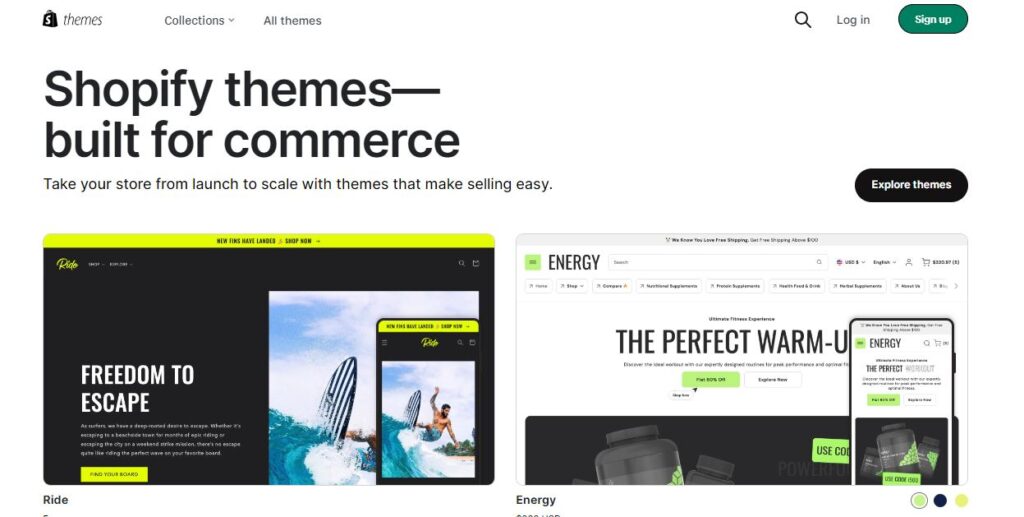
Shopify is a designer’s dream, offering a blank canvas for businesses to craft their online store’s aesthetic. With over 100 stylish templates and the ability to filter by industry, you can find a theme that aligns with your brand’s identity and product offerings.
Once you’ve selected a theme, Shopify’s user-friendly editor empowers you to customize every aspect of your store’s design. From rearranging layouts and adjusting color schemes to adding your own content and images, the possibilities are endless. Shopify even provides a vast library of stock images, ensuring you can create a visually stunning online presence even if you don’t have your own product photography initially.
eBay: Branding and Customization
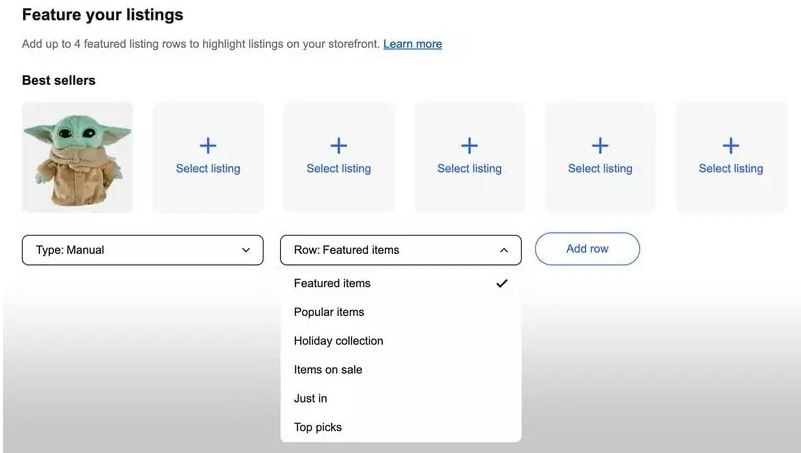
While eBay’s primary focus is on providing a vast marketplace for buyers and sellers, it offers limited design customization options. As a seller, your store will always be hosted on the eBay platform, which means you’ll have to adhere to eBay’s branding guidelines.
If you’re an eBay Store subscriber, you can add a header image and tweak the color scheme to align with your brand’s aesthetic, but that’s about the extent of customization options. Personal sellers have even fewer options, with the ability to change only their store’s profile pictures.
While eBay’s design limitations may be a drawback for businesses seeking a unique online presence, it does offer the advantage of immediate access to eBay’s massive global audience, which can be a significant boon for driving sales and exposure.
Shopify vs eBay: Ecommerce Tools and Features
At the heart of any successful online business lies a robust suite of ecommerce tools and features. Both Shopify vs eBay offer a range of capabilities, but their focus and depth of offerings differ significantly.
Shopify Tools and Features
As a purpose-built ecommerce platform, Shopify excels in providing a comprehensive set of tools and features designed to streamline every aspect of your online business. From selling an unlimited number of products and managing inventory to offering discount codes, abandoned cart recovery, and gift cards, Shopify has you covered.
One of Shopify’s standout features is its multi-channel selling capabilities, allowing you to reach customers across various social media platforms and marketplaces, including eBay itself. Additionally, Shopify provides powerful shipping tools, including label printing, third-party shipping rate calculations, and exclusive discounts for Shopify users.
If there’s a feature or functionality missing from Shopify’s core offering, you can easily extend its capabilities through the vast Shopify App Store, which boasts thousands of integrations and add-ons.
Learn more: Best Shopify Apps For Dropshipping 2024
eBay Tools and Features
As a marketplace focused on facilitating transactions between buyers and sellers, eBay’s ecommerce tools and features are more basic in nature. While it offers essentials like a shopping cart function, advanced search filters, product reviews, wish lists, and favorites, its capabilities are geared more towards listing and selling products rather than building a comprehensive online store.
eBay Store subscribers gain access to additional tools like the Promotions Manager and Markdown Manager, which allow for setting up discounts and sales on products. However, for more advanced ecommerce management features, such as inventory tracking, sales reporting, and automated relisting, you’ll need to upgrade to eBay’s Selling Manager Pro, which comes at an additional cost.
Shopify vs eBay: Marketing Tools and Growth Potential
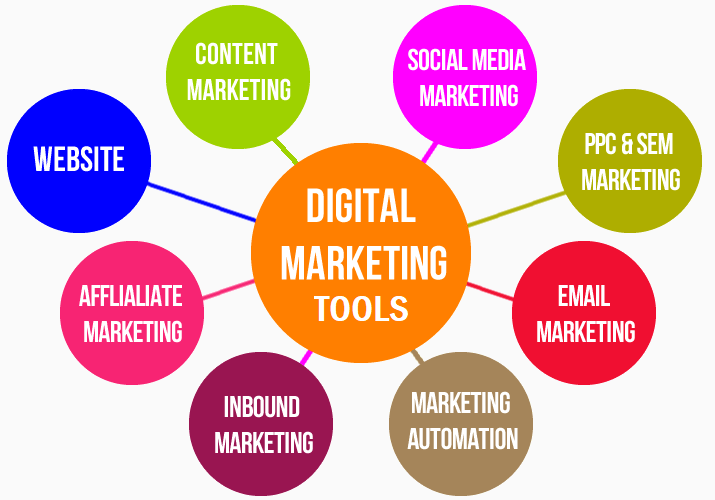
In the ever-evolving ecommerce landscape, effective marketing and growth strategies are crucial for success. Both Shopify vs eBay offer a range of marketing tools, but their capabilities and approach to growth differ significantly.
Shopify Marketing Tools
Shopify is a powerhouse when it comes to marketing and growth potential. With its comprehensive suite of analytics tools, you can gain deep insights into your store’s performance, customer behavior, and areas for improvement. Shopify even integrates seamlessly with Google Analytics, providing an additional layer of data-driven decision-making.
Social media integrations are a breeze with Shopify, allowing you to connect with platforms like Facebook, Instagram, and TikTok, expanding your reach and engaging with potential customers. Additionally, Shopify’s robust email marketing capabilities, including its native Shopify Email platform and integrations with third-party email marketing tools, enable you to nurture customer relationships and drive repeat business.
Search Engine Optimization (SEO) is another area where Shopify shines. With custom URLs, meta titles, descriptions, image alt text, and helpful SEO tips during product uploads, Shopify equips you with the tools necessary to improve your online visibility and drive organic traffic to your store.
Learn more: Best SEO Apps for Shopify You Need In 2024
eBay Marketing Tools
While eBay’s primary strength lies in its vast global marketplace and built-in audience, its marketing tools and growth potential are somewhat limited compared to Shopify.
eBay provides seller performance reports, traffic and sales analytics, and listing analytics, offering a broad overview of your store’s performance. However, these tools lack the depth and granularity found in Shopify’s analytics suite.
One notable feature offered by eBay is the Terapeak Product Research Insights tool, available to eBay Store subscribers. This tool allows you to analyze how products similar to yours are performing across the eBay marketplace, providing insights into popular niches and competitor performance.
Social media integrations on eBay are more limited, with the ability to connect primarily with your Facebook account. While each listing includes sharing buttons for Twitter and Pinterest, the overall social media integration capabilities are not as robust as Shopify’s offerings.
Email marketing on eBay is also somewhat restrictive, with limited customization options and a lack of comprehensive email analytics. Building and nurturing a subscriber list can be challenging due to the platform’s restrictions and the inherent competition with other marketplace sellers.
Shopify vs eBay: Help and Support
No matter how user-friendly an ecommerce platform is, challenges and roadblocks are bound to arise. In such situations, having access to reliable and comprehensive support resources can make all the difference. Both Shopify vs eBay offer various support channels, but their approach and depth of assistance differ.
Shopify: Help and Support
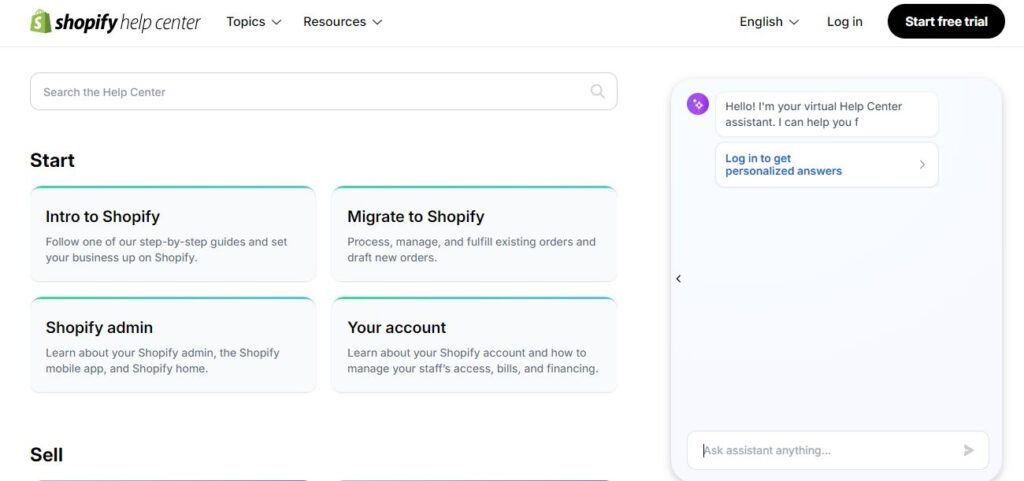
Shopify excels in providing a multitude of support options to ensure that you’re never left stranded. Whether you prefer to speak with a live agent or prefer self-guided resources, Shopify has you covered.
For those seeking immediate assistance, Shopify offers 24/7 phone support, live chat, and social media support channels. If you prefer written communication, you can reach out via email, and Shopify’s prompt response times ensure your queries are addressed swiftly.
In addition to direct support channels, Shopify provides a wealth of self-help resources, including a comprehensive help center, video tutorials, and an active community forum where you can connect with fellow merchants and Shopify experts.
For businesses requiring more specialized assistance, Shopify offers advanced specialist support, ensuring that even the most complex challenges are addressed by knowledgeable professionals.
eBay: Help and Support
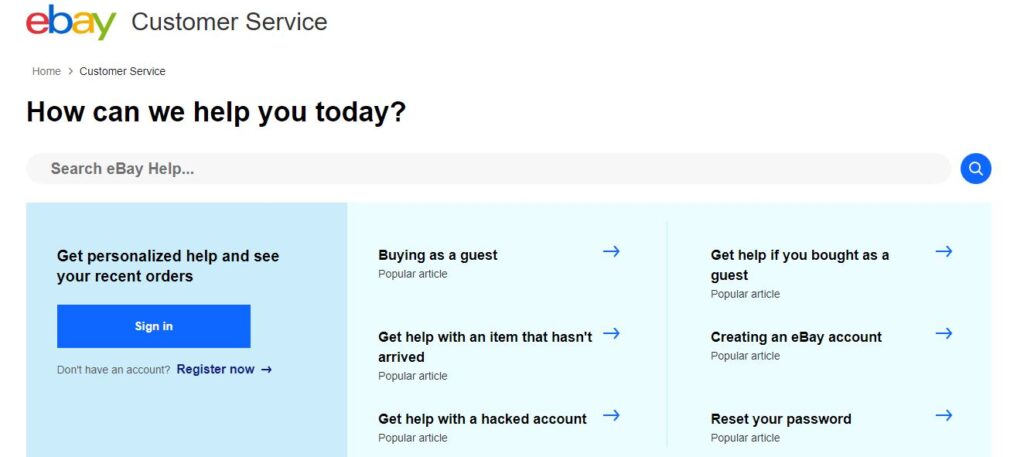
eBay’s approach to support is a mixed bag, with both strengths and areas for improvement. While the platform offers 24/7 chatbot support, live chat, and phone support channels, accessing human assistance can sometimes be a challenge.
One area where eBay shines is its comprehensive help center, which houses a vast collection of articles and guides covering a wide range of topics. However, navigating this wealth of information and finding the specific answers you need can be a daunting task at times.
eBay also boasts an active community forum, allowing you to connect with fellow sellers and seek advice or solutions from experienced users. However, the lack of easily accessible email support can be a drawback for those who prefer written communication.
Integrating Shopify and eBay: The Best of Both Worlds
While Shopify vs eBay offer distinct advantages and cater to different business needs, you don’t necessarily have to choose one over the other. Thanks to Shopify’s robust integration capabilities, you can leverage the strengths of both platforms simultaneously.
By accessing the Shopify App Store, you can download and integrate the eBay app, allowing you to sell your Shopify products seamlessly on the eBay marketplace. This integration process is straightforward, with Shopify guiding you through the steps and even offering an option to import your products in bulk.
Selling across both platforms can be a powerful strategy for businesses seeking to expand their reach and tap into eBay’s vast audience while maintaining a fully branded and customized online store with Shopify. However, it’s important to note that managing a multi-channel ecommerce presence requires a higher level of commitment and resources.
Shopify vs eBay: The Final Verdict
After an in-depth exploration of Shopify vs eBay’s capabilities, strengths, and weaknesses, it’s clear that both platforms offer unique advantages tailored to different business needs and goals.
Shopify: The Ideal Choice for Brand-Focused Growth
Shopify shines as the premier choice for businesses seeking to establish a strong brand identity and foster long-term growth. With its unparalleled design flexibility, comprehensive ecommerce tools, and robust marketing capabilities, Shopify empowers you to craft a visually stunning online store that resonates with your target audience.
Whether you’re a budding entrepreneur or an established brand seeking to expand your online presence, Shopify’s scalable solutions and constant innovation ensure that your business remains at the forefront of the ever-evolving ecommerce landscape.
eBay: The Marketplace for Simplicity and Reach
eBay, on the other hand, excels as a marketplace for businesses that prioritize simplicity and immediate access to a vast global audience. While its design customization options are limited, eBay’s user-friendly interface and streamlined selling process make it an attractive choice for those seeking a hassle-free entry into the world of ecommerce.
For businesses focused on reselling products or testing the waters before committing to a full-fledged online store, eBay’s established marketplace and built-in traffic can provide a valuable platform for generating sales and gaining exposure.
Ultimately, the decision between Shopify vs eBay hinges on your business goals, growth aspirations, and the level of control and customization you desire over your online presence. By carefully weighing the pros and cons of each platform, you can make an informed choice that aligns with your unique business needs and sets you on the path to ecommerce success.
What are the Pros and Cons of Selling on eBay?
Selling on eBay comes with its own set of advantages and drawbacks:
Pros:
- Immediate access to a vast, built-in audience
- User-friendly interface for listing and selling products
- Established reputation and trust among online shoppers
Cons:
- Limited branding and customization options
- Higher competition, potentially leading to reduced profitability
- Complex fee structure with various charges beyond the subscription cost
While eBay provides a convenient platform for small sellers looking to get started quickly, businesses seeking long-term growth and brand recognition may find Shopify’s comprehensive ecommerce solutions more aligned with their goals.
Frequently Asked Questions
Which Platform is Better for Dropshipping: Shopify vs eBay?
For most sellers, Shopify emerges as the more suitable option for dropshipping businesses. The platform seamlessly integrates with numerous apps and tools designed to automate and streamline the dropshipping process. In contrast, dropshipping on eBay often requires more manual setup and configuration, potentially hindering efficiency and scalability.
Can I Sell My Shopify Products on eBay?
Absolutely! Shopify’s integration capabilities allow you to leverage the best of both worlds. By utilizing the eBay app available in the Shopify App Store, you can sync your Shopify products with your eBay store, enabling you to tap into eBay’s vast customer base while maintaining a branded online presence through your Shopify store.
Which Platform Offers Lower Fees: Shopify vs eBay?
When it comes to fees, Shopify generally offers a more cost-effective solution, especially for businesses with larger product catalogs or higher sales volumes. While Shopify charges a monthly subscription fee and payment processing fees (unless using Shopify Payments), there are no additional listing or transaction fees. In contrast, eBay’s fee structure is more complex, with sellers incurring various fees, including insertion fees, final value fees, and potential payment processing fees.
Is Shopify or eBay More Beginner-Friendly?
For beginners venturing into the ecommerce realm, Shopify emerges as the more beginner-friendly option. The platform offers extensive support resources, including guides, tutorials, and a comprehensive help center, making it easier for new merchants to navigate the process of setting up and managing their online stores. Additionally, Shopify’s user-friendly interface and intuitive design tools contribute to a smoother learning curve.
Conclusion
In the dynamic world of ecommerce, the choice between Shopify vs eBay is a pivotal decision that can shape the trajectory of your online business. By carefully evaluating your unique needs, goals, and growth aspirations, you can make an informed choice that aligns with your vision for success.
Shopify emerges as the premier platform for businesses seeking to establish a strong brand identity, foster long-term growth, and leverage cutting-edge ecommerce tools and marketing capabilities. Its unparalleled design flexibility, comprehensive feature set, and scalable solutions ensure that your online store remains at the forefront of the ever-evolving ecommerce landscape.
On the other hand, eBay excels as a user-friendly marketplace, providing immediate access to a vast global audience and a streamlined selling process. While its customization options are limited, eBay’s established reputation and built-in traffic can offer a valuable platform for resellers, small businesses, and those testing the waters before committing to a full-fledged online store.
Ultimately, the decision between Shopify vs eBay is a reflection of your business goals, priorities, and desired level of control over your online presence. By carefully weighing the pros and cons of each platform, you can make an informed choice that sets you on the path to ecommerce success, whether that means building a branded online empire or tapping into the power of a global marketplace.



